Yes, we're now running our Black Friday Sale. All Access and Pro are 33% off until 2nd December, 2025:
How to Calculate the Area of a 2D Polygon?
Last updated: February 18, 2023
1. Overview
Many ways exist to compute the area of geometric shapes using mathematical formulas. Here, we will focus only on 2D polygons. A polygon consists of a finite number of connected segments that we can represent as a set of consequential points.
There are different formulas to compute the area of regular polygons and several techniques for decomposition. However, the area of non-regular polygons is a bit hard to compute.
In this tutorial, we’ll learn how to calculate the area of an arbitrary 2D polygon using some basic operations from linear algebra.
2. Main Definitions and Operations
First, we must understand a few concepts about 2D vectors and matrices.
2.1. Vector
A vector in a 2D space is a geometric object described by its magnitude and direction or . For example, we can view a vector
as the displacement from point
to point
:
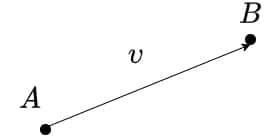
The figure above represents a vector described by two points and
with coordinates
and
respectively. Then, the vector is
.
2.2. Matrix and Determinant
A matrix is a 2D array of numbers with rows and
columns. When
, the matrix is square and has a determinant, a unique value that characterizes the matrix.
To compute the determinant of a matrix, we should multiply the top-left and bottom-right elements of the matrix (also called the main diagonal). Then, subtract from this the product of the bottom-left and top-right elements:
3. Area of Triangle
Let’s start by computing the areas of a triangle, and a parallelogram, then extend this to other geometric shapes. Linear algebra provides straightforward formulas to calculate the area of triangles and parallelograms if we know the coordinates of all the vertices on the 2D plane.
So, suppose we have a parallelogram:
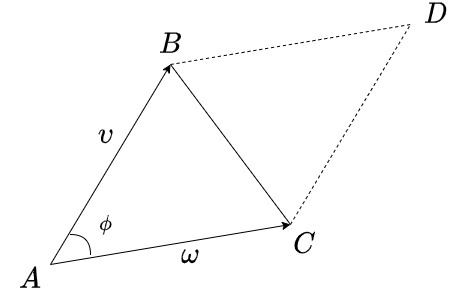
The area of a parallelogram is . Alternatively, the area is also equivalent to the determinant of a square matrix with vectors
and
as columns:
.
Consequently, the area of the triangle is: .
For example, let’s compute the area of the following triangle:
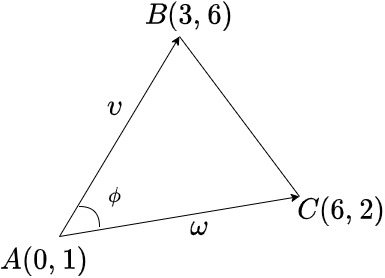
.
.
Here, clockwise ordered vectors and
yield a negative area. Instead, counter-clockwise vectors return a positive area:
.
This formula for area is a very efficient computation as it doesn’t involve roots or trigonometric functions. Instead, there are just two multiplications, five additions, and possibly one division by two.
4. Area of Polygon
Let’s use this understanding on a generic 2D Polygon.
4.1. Idea of Computation
First, a simple polygon with vertices has no self-intersections and can be decomposed into
triangles. We can calculate the signed areas of each triangle and then add them together to calculate the total area of the polygon. As seen previously, the resulting area can be either positive or negative depending on the order of evaluation.
Mathematically speaking, given an arbitrary point on the 2D space and
the vertices of the polygon and
to close the polygon. We can compute the area as the sum of all areas of triangles
.
4.2. Why It Works
Let’s look at the example of the polygon and point :
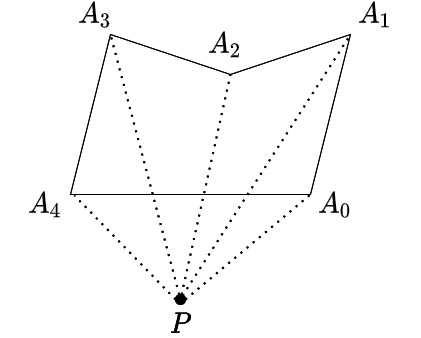
We have to calculate the area of five triangles: .
Above, we evaluate the orientation of the first four triangles counter-clockwise and the last one clockwise. Therefore, the area of the first four triangles must be positive, and the last one must be negative. This difference will remove the extra area not contained in our polygon. The extra space, in our case, is precisely the triangle: .
4.3. Formula to Compute the Polygon Area
We may choose a specific point to simplify the final computation formula. Assume we have a polygon represented with the set of
points
. Thus, the formula that computes the area of the polygon:
, where
with
.
Above is the sum of all triangle areas formed with each line segment of a polygon. Remember, we have to include all polygon edges, and the last triangle of the sum will be triangle . Thus, the index
.
5. Green’s Formula
Finally, let’s prove the above formula. Referring to mathematical analysis, we should know about Green’s Theorem.
Let be our polygon line segments. Let
be a region bounded with
. Notice
is our target region. The goal is to compute its area
. Suppose
and
are functions, defined on
. Then, Green’s Theorem states:
So, in order to compute the area of polygon , we need to choose
and
such that:
. The appropriate choice is
and
. Thus, if
is our target polygon area, the formula transforms to
.
Importantly, is our polygon line segments
and
. And the area:
. Also, we assume all line segments are oriented counter-clockwise.
To compute each integral in the sum, we can represent each line segment: ,
,
.
The last thing that we need to do is to substitute the parameterization:
.
And the final formula that computes the target polygon area:
.
6. Example of the Polygon Area Calculation
Let’s use the formula just described and calculate the area of the polygon the following polygon
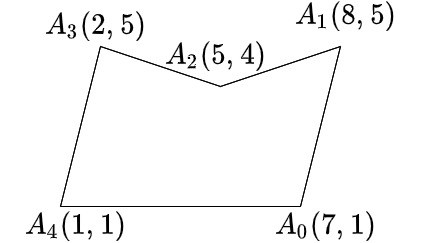
If we choose the point , then the area is:
To emphasize, notice that our target point is on the bottom-left of our polygon. As a consequence the areas of
are positive and the areas of
are negative. As expected, the extra computed area is exactly
and
.
7. Conclusion
In this article, we’ve introduced a way to calculate the area of a 2D polygon. Furthermore, we’ve touched on some major topics of linear algebra. Moreover, we also introduced methods to calculate the area of the triangle and parallelogram, as they are specific polygons.